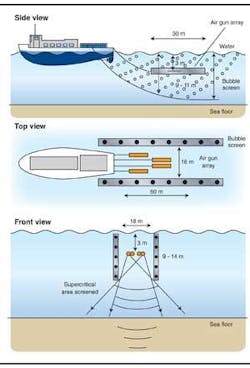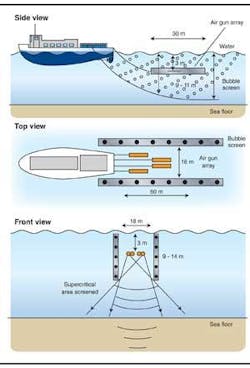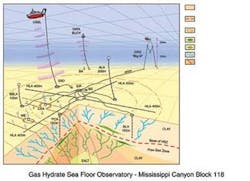Seismic survey noise under examination
Jesse Spence - Noise Control Engineering Inc.
The impact of seismic exploration on marine life is becoming an ever more prevalent consideration for the offshore oil and gas industry. Discussion continues on exactly how much sound is acceptable, but owners and operators today increasingly must comply with regulatory agency rules. Specialized procedures such as air-gun ramp-ups, aerial or on-board mammal spotters, and even limiting the scope of the planned exploration, all cost time and money and require careful attention. Research from Noise Control Engineering Inc. into current and future methods to reduce underwater sound from all oil and gas industry activities includes seismic exploration as well as other activities such as construction, decommissioning, vessels, platforms, and more. The work was funded by the Joint Industry Program on E&P Sound and Marine Life (JIP), a group organized under the International Association of Oil and Gas Producers.
In performing this work, NCE researched journal articles, technical and trade magazines, and contacted industry, government, and academic representatives to find existing and potential methods for underwater sound reduction. Mid-way though the research, a two-day conference was held on the topic of underwater noise reduction for oil and gas industry operations. NCE invited experts in the fields of underwater noise, treatment vendors, university researchers, and oil and gas industry representatives. Participants were encouraged to discuss the research findings and to introduce their knowledge and experience.
Compared with other offshore oil and gas activities, seismic exploration (air guns in particular) produces among the loudest sounds. To understand how to reduce sound from air guns (or any source), one must first understand what kinds of sounds are created and how they are created. The sound spectrum output from an air gun can be divided into two categories: frequencies useful to seismic exploration and extraneous frequencies. “Useful” sound typically is in the range of 100 Hz and below, while any output above this usually is ignored for data collection purposes. Many sea animals have hearing that is focused primarily in the higher frequency range, and a potential method for reducing the impact to such animals would be to limit the output of seismic signals to the useful frequency range. Ideally, such an approach would not affect the quality of the seismic data.
Unfortunately, there is no off-the-shelf treatment to reduce underwater sound. One attempt is to create an “air-gun silencer.” Sound absorbing material was suspended on radially oriented plates around a conventional air gun. While modest reductions in sound were seen at frequencies above 700 Hz, implementation of the treatment was impractical; the material degraded after 100 shots, and only worked for low pressure air guns.
Bubble curtains may block some sound created by seismic exploration. An air bubble curtain is located on either side of a conventional seismic array to create a sound barrier. An application of this approach has been tried. The original intent was not to reduce underwater sound that may affect marine life, rather it was meant to improve data quality in a specific shallow-water location due to acoustic modes. NCE has been involved in modeling efforts to determine the feasibility of this approach to reduce the area affected by seismic sounds. While not final, the approach appears to have merit, at least in areas where the sea floor is deep enough to cause minimal reflections and interference (currently estimated to be depths greater than 100 m (328 ft). Sound reductions of 10-20 dB may be possible using this approach, though field experiments are required to verify this.
There are several other approaches to reduce unwanted sound during seismic exploration which appear to be more effective. However, these use sources other than conventional air guns. One approach is referred to as Marine Vibroseis. Here, an “underwater speaker” creates sound only in the useful frequency range below 100 Hz. The decrease in acoustic output is 50-100 dB per decade above 100 Hz, compared to air guns which are on the order of 30 dB per decade. The potential for sound reduction is large, particularly, at higher frequencies.
There are several published approaches to Marine Vibroseis. Typically, the sound from these sources is either a pseudo-random pulse, swept sine wave, or other known signal. The signal is stretched in time relative to the short impulse from an air gun. By summing the acoustic energy over a few seconds, the Marine Vibroseis signal can achieve good data quality without the high peak sound levels seen from air guns.
There is another potential advantage to using a known, repeatable signal. It is possible to use “cross-correlation” and other advanced processing techniques to pull a low-level seismic signal out of background noise. Using this approach, not only is the instantaneous sound pressure lower than conventional sources, but the total acoustic energy output can be reduced.
Marine Vibroseis is not yet commercially viable. Reliability of the vibroseis source is a subject of continued research. Methods to improve data quality also are being examined, though comparisons provided in the literature do show strong similarities to air-gun data. Marine Vibroseis sources currently are being used as an alternative to explosive seismic sources in shallow water and to perform vertical seismic profiling.
Other approaches use ambient sounds such as wind noise, wave noise, or small seismic events that occur on a regular basis. These techniques use permanent or semi-permanent moored hydrophone arrays to collect ambient sound data. After collecting the data, specialized mathematical processing techniques are used to create seismic data and identify geological features below the sea floor. This approach completely removes the need for conventional seismic sources, and no additional anthropogenic sound is generated during the survey.
The main downside to these techniques is the time to acquire enough data to be useful. The time depends on the strength of the acoustic signal, among other factors, but can be hours, days, weeks, or longer. However, it has been shown that normal ship noise can also be used for this purpose. These are vessels of opportunity, rather than vessels specifically built or designed for seismic exploration. With the larger acoustic output of vessels relative to other ambient sources, acquisition times can be shorter.
While these approaches likely will have limited usefulness for exploration of new areas, they pose an opportunity for life-of-field type of studies. Where the exploration area is pre-determined, hydrophone arrays could be permanently moored and ambient or vessel noise is likely to be prevalent.
Lastly, it may be possible to alter the design of an air gun to reduce high frequency output. Perhaps modifications could be made that would reduce the peak pressure of an air gun, subsequently reducing the output in the higher “extraneous” frequency range while maintaining output in the lower “useful” frequency range.
More work clearly is needed to make any of these options or others viable on a commercial basis. However, there are potentials for reducing sounds from seismic exploration which can lead to a reduced need for regulatory involvement in day-to-day operations. While no single technique would necessarily replace air guns and other conventional approaches, in certain situations having alternatives may mean the difference between getting the data or going home disappointed.
To obtain a copy of the report, contact Jesse Spence ([email protected]). The report discusses, in detail, the pros and cons of each approach mentioned above, other treatments and techniques for seismic exploration, and also provides methods of sound reduction from many other oil and gas industry sound sources.
References
Askeland, B., B. Ruud, H. Hobæk, and R. Mjelde. 2006. A seismic field test with a Low level Acoustic Combustion Source and Pseudo Noise codes. Submitted to Marine Geophysical Researches.
Askeland, B., H. Hobæk, and R. Mjelde. 2007. Marine seismics with a pulsed combustion source and Pseudo Noise codes. Marine Geophysical Researches. DOI 10.1007/s11001-007-9018-5.
Davies, K., G. Hampson, H. Jakubowicz, and J. Odegaard. 1992. Screw Seismic Sources. Society of Exploration Geophysicists Technical Program Expanded Abstracts. pp. 710-711. doi:10.1190/1.1822196.
Koch, R.A. and D.P. Knobles. 2005. Geoacoustic inversion with ships as sources. Journal of the Acoustical Society of America. 117(2):626-637.
Nedwell, J. and B.E. Edwards. 2005. Initial tests of an air-gun silencer for reducing environmental impact. Subacoustech report reference: 644 R 0108. Submitted to Exploration and Production Technology Group, BP Exploration.
Park, C., W. Seong, and P. Gerstoft. 2005. Geoacoustic inversion in time domain using ship of opportunity noise recorded on a horizontal towed array. Journal of the Acoustical Society of America. 117 (4):1933-1941.
Sixma, E. and S. Stubbs. 1996. Air Bubble Screen Noise Suppression Tests in Lake Maracaibo. Sociedad Venezolana de Ingenieros Geofisicos Congreso Venezolano de Geofisica.
Tenghamn, R. 2006. An Electrical Marine Vibrator with Flextensional Shell. Exploration Geophysics. 37(4):286-291.
Sound & marine life: promoting scientific solutions
Dr. John Campbell, Technical Director - International Association of Oil & Gas Producers
What impact does the sound produced by exploration and production operations have on marine life?
Until recently, no one had any idea. There has been speculation, of course. Every time a young whale got lost up river or a pod stranded on the beach, there would often be claims that the event was caused by upstream seismic work or other E&P-related activities.
But no one could speak with certainty for the simple reason that there had been insufficient research on the science of E&P sound and its possible impact on marine life.
Just over two years ago, that situation began to change.
In 2005, Mark Solien, VP - Technical for ExxonMobil Exploration, gathered peers in industry to discuss this emerging issue and the lack of good information to guide industry operations.
In May 2006, several oil and gas companies and an industry association established a Joint Industry Program (JIP) on Sound and Marine Life. The International Association of Oil & Gas Producers (OGP) was engaged to manage the JIP.
The JIP’s objective is to advance the scientific understanding of the effects of sound generated by offshore oil and gas exploration and production operations on marine mammals, fish, and turtles through independent research projects – undertaken by some of the foremost scientists and institutions in this field.
In the first three-year period of the JIP, industry has committed approximately $24 million allocated to approximately 60 projects in five research categories:
- 1. Sound source characterization and propagation
- 2. Physical, physiological, and hearing effects
- 3. Behavioral reactions and biologically significant effects
- 4. Mitigation and monitoring
- 5. Research tools.
In October 2008, the JIP held its first Program Review Meeting (PRM) in Houston. The three-day event attracted some 150 participants including regulators, academics, NGO representatives, and staff from upstream operating and service companies.
One benefit of the program review was to enable discussion among the scientists’ stakeholders which promoted new ideas for future research. Thanks to their efforts, we now are pursuing an understanding of how our operations impact marine life. And, to ensure that the new scientific knowledge is transparent and broadly available, all research findings will be published so that they can be peer reviewed and form the basis for future research by others.
A range of projects were covered. One study, for instance, engaged in fieldwork in the Gulf of Mexico to help define with scientific precision – and for the first time – the three-dimensional nature of sound made by a typical industry air gun array. Another is working on a strategy to measure hearing in whales that communicate at frequencies identical to those produced by air guns. A third is looking to develop technology to track and monitor marine mammals during industry operations.
Our knowledge of where whales go, how deep they dive, or how they behave has been limited largely to researchers with binoculars on the beach or in a boat watching them when they surface. Therefore, one aspect of the research program is to develop the tools to expand our understanding of the marine environment. For example, work on electronic tags used to track whale movements will lead to the development of better devices. With this knowledge industry can use more effective mitigation measures and reduce potential impacts
To increase our knowledge base even more, the members of the JIP are now discussing an extension of its funding period for another three years, with a proportionate increase in new financing for additional research projects.
This is good news for everyone involved, including the regulators who want to make science based decisions. In some situations the absence of knowledge has led some regulators to restrict– perhaps needlessly – access to essential exploration and production acreage offshore.
For more information about the JIP, visitwww.soundandmarinelife.org


